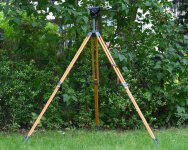The difference may not be noticeable, but it is there because of the reduced diameter of the bottom leg sections. You can't beat the laws of physics.
Apart from that, any fully extended joint is going to introduce instability so some overlap is desirable, and setting up a 4-section tripod with overlap in all 9 joints is a PITA.
Allegedly RRS joints are very good but you could try laying the tripod on a table with the next fully extended thinner section overhanging.
Gitzo, Sirui, Novoflex all wobble.
John
I don't disagree with anything you shared. As you said, it is physics. But one has to look at the entire package objectively, not just the number of leg sections. You have to compare leg diameters between brands. Consider other features that are important and can offset just looking at the number of leg sections, such as comparing heights without center column, collapsed length and weight, etc. It comes back to the tripod being part of a whole system and not just leg sections.
(As a quick aside... extending four twist lock leg sections is easy. Grab all of them with one hand, turn 1/4 turn, drop, quick tighten. But that will be personal preference.)
Since the Really Right Stuff (RRS) tripods aren't talked about a lot on this forum, and Gitzo is, this presents a good opportunity to use both as an example of what I am meaning. I know this is long, but some of this is reasoning I wish I had read on the forums when we were first looking at gear.
When I was comparing tripods I made up a spreadsheet with the specs of each brand and model I was considering. Included was the diameter of each leg section, including the leg diameters for our three section ATM (aluminum, titanium, magnesium) tripods. Also included were working heights with center column collapsed, overall collapsed length, and weight.
The RRS four section TFC-34 Series 3 has leg diameters that measure 1.44", 1.30", 1.14", 0.97".
The Gitzo three section Mountaineer Series 3 has leg diameters that measure: 1.3", 1.13", 1".
The Gitzo four section Mountaineer Series 3 has leg diameters that measure: 1.3", 1.13", 1", 0.85"
As you can see on the RRS TFC-34 legs 1, 2, and 3, are larger diameter than the Series 3 Mountaineer, and the RRS's "small" 4th leg section is essentially the same 1" leg diameter as the three section Mountaineer. So one can't assume that a four section tripod will automatically have smaller legs than a three section tripod. Then we see that each leg section of the RRS TFC-34 is larger diameter than the four section Mountaineer. So even though both brands are "Series 3" carbon fiber, each manufacturer's "Series 3" is a little different.
But a tripod is more than just legs. Working height, apex, center column, leg spread all come into play.
The Mountaineer Series 3 has a maximum height of 52.36" with the center column collapsed and legs fully extended.
The RRS TFC-34 has a maximum height of 58.2" with legs fully extended, but... it has no center column. It uses a single piece fixed apex at the top.
Everyone says a center column makes a tripod less stable. Eliminate the center column and stability increases.
With 5.84" of extra height one can collapse the RRS TFC-34 legs to overlap about 1.94” at each joint (call it 2”) and increase stability, have the same working height as the Mountaineer, and still not have a center column as a weak point. Or one could retract only the botton leg section that 5.84”. Because of the height of the RRS TFC-34 we mostly use it with certain legs sections slightly collapsed increasing joint stability.
So which is better, the RRS or the Gitzo? It also depends on other needs.
The Gitzo is 25.2" long when fully collapsed, and it weighs 4.14 lbs (legs only).
The RRS TFC-34 is 20.9" long when fully collapsed, and it weighs 3.9 lbs (legs only).
If you want/need a tripod that collapses to a length shorter than 25" the Mountaineer, regardless of how stable, won't meet the need. And if you switch to a four section Mountaineer Series 3 you end up with four legs smaller in diameter than the RRS TFC-34.
This is why one has to look at the whole system.
In our experience the RRS TFC-34 with four leg sections meets our needs where a three section tripod wouldn't. It is a stable platform for us because of how the whole of the tripod is built.







